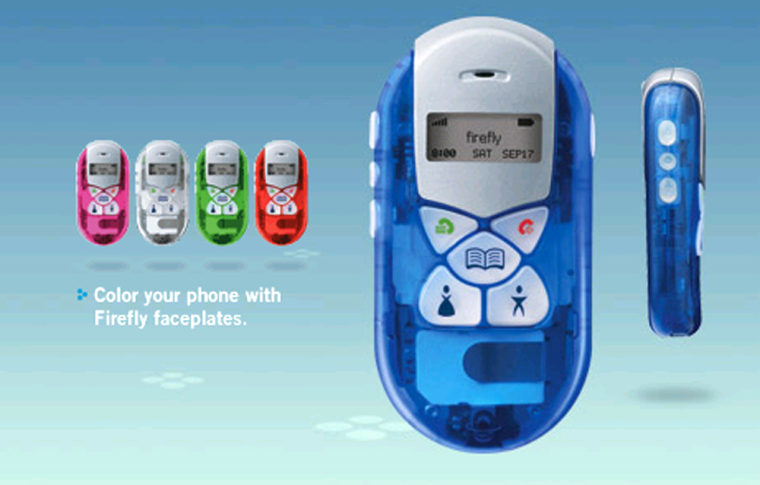There's something disquieting about giving a child an expensive piece of technology, and something absurd in the idea that kids need to stay in constant contact.
But after playing with a kid-centric phone from Firefly Mobile for a few days, I'm starting to come around. This new device could be a useful tool, providing a convenient way for children to stay in touch with their family. But first the phone is going to have to grow out of its infancy, and adults are going to have to get to the point where they can hear the phrase "cell phone for kids" and not cringe in horror.
Cringe if you like, but it's hard to argue with the business case for such a device. Pretty much every adult aged 25 to 55 who wants a mobile phone— about 80%, according to the Cellular Telecommunications and Internet Association— already has one. This fact has made kids the fastest-growing and least-penetrated portion of the wireless marketplace, a wide and growing swath of unconnected consumers. In 2000 only a single-digit percentage of kids had a wireless phone, but that changed by 2003, when some estimate one-third of U.S. kids aged 11 to 17 had one.
Kids love to talk, they love to send text messages and to download custom ring tones, and they put a high premium on having the newest and most stylish devices. That sounds like a market that should have wireless carriers advertising during cartoon shows faster that you can say Yu-Gi-Oh.
But the biggest barrier to penetration in this market is parents. Most adults don't want to shell out the cash to buy their kids a phone, nor do they want the kid to suddenly have all the freedom opened up by their own, unmonitored phone line.
Firefly Mobile launched in 2002 with the intention of navigating those hurdles. Three years later, they've got a phone on the market: a cute, palm-sized object that looks a bit like it's derived from the original Apple Computer iMac, all curves and transparent tinted plastic.
Instead of a standard keypad, it has just a handful of buttons; kids have to press preprogrammed "Mom" or "Dad" keys to phone home. Parents can program a third button with up to 20 other speed-dial options, and set the device to only accept calls from those numbers.
The Firefly phone is targeted at kids who fall into the "tween" demographic — roughly between the ages of 8 and 12 — an age group some may argue is too young for a full-fledged mobile phone, yet old enough to want one. They're also old enough and often just independent enough that a parent may be willing to pay to be able to check in with them whenever they want.
There's also plenty to attract tweens. The Firefly sells with a variety of faceplates, allowing kids to customize the device. They can also assign different 12 different ring tones, and a "Fireworks" button causes the phone to strobe colorfully for 30 seconds.
Some of the features to which kids would be most attracted have intentionally been left out. The device has neither games, nor text messaging, nor Internet access. This fact should help Firefly cross one of its biggest hurdles: the near-universal ban on wireless phones in schools. Teachers tend to regard cell phones as a either a distraction or a vehicle for cheating, and bringing one into class is usually a good way to lose it.
But the Firefly was conceived from the start as school-friendly. "When we designed this from the ground up, we consciously said it should have voice only," says Chief Executive Robin Abrams. "Our goal is to end up having Firefly-friendly campuses." Firefly's carriers already are taking their case to local PTAs and arguing that the device should be allowed in schools, she says.
Another major hurdle is the price. Firefly has launched the phone on SunCom Wireless, a division of Berwyn, Penn.-based provider Triton PCS, which sells the device for $199, complete with 1,200 prepaid cellular minutes. On March 18, Firefly launches on Cincinnati Bell. And in May, Firefly will sell the phone with 30 minutes of prepaid talk time for $99, direct from its own Web site, fireflymobile.com.
That's a lot of cash to spend on a phone that could easily get misplaced. To address that concern, Firefly plans to roll out an insurance plan this summer, allowing parents to pay a small monthly premium to protect against loss. And Abrams makes a good argument that kids will hang onto the phone. "Kids in this age group understand being responsible for things they care about," she says. "They want to wear it; they're proud of it."
Firefly's not the first to go after consumers in the under-18 set. A Seattle-based startup called Wildseed, founded by Eric Engstrom, a former Microsoft executive, created a curvy-shaped phone aimed at teens.
But it's still likely that parents will balk at handing hundreds of dollars worth of small, easily misplaced hardware to their second grader. And they'll shudder when they see how flimsy the thing is. The first-edition Firefly I tested is so easily disassembled — the back has a huge and enticing latch that cracks the thing open, exposing its circuitry — that I wonder how long it would actually survive in the hands of an average kid.
The Firefly may not be the perfect device, and the world might not be ready just yet for telecom for tots. But the success of devices like this one is pretty much inevitable. There's too much money to be made — and too many anxious parents — to ignore the cellular market for kids.
